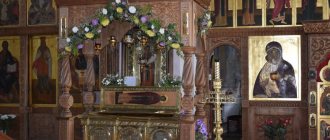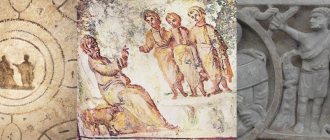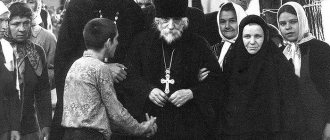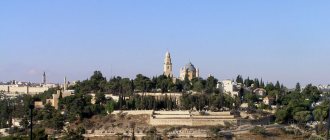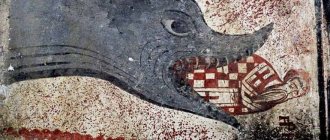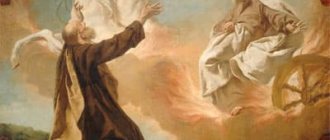The religion that created the civilization of Europe, which determined the cultural identity of Russia, is a kind of pinnacle, when everything possible has already been said about man and his salvation. This is Christianity - a world religion, first among others in terms of the number of followers. The article very briefly and popularly outlines the entire history of Christianity from its inception to the present day.
Fundamentals of Christianity: what is the essence of religion
According to surviving documentary sources, Christianity originated in the 1st century AD, in the territory of modern Palestine. Born in Nazareth, into a simple family of a potter, the preacher Jesus Christ brought a new teaching to the Jews - about one God. He called himself the son of God, whom the Father sent to people to save them from sin. The teaching of Christ was a teaching about love and forgiveness. He preached nonviolence and humility, confirming his beliefs by his own example. The followers of Jesus were called Christians, and the new religion was called Christianity. After the crucifixion of Christ, his disciples and supporters spread the new teaching throughout the Roman Empire, and soon throughout Europe.
In Rus', Christianity appeared in the 10th century. Before this, the religion of the Russians was paganism - they deified the forces of nature and worshiped them. Prince Vladimir, having married a Byzantine woman, accepted her religion. Despite the resistance that arose everywhere, soon all of Rus' underwent the rite of baptism. Gradually, the old faith was forgotten, and Christianity began to be perceived as an original Russian religion. Today there are more than 2 billion followers of the teachings of Christ in the world. Among them, approximately 1.2 billion consider themselves to be Catholic, about 0.4 billion are Protestant, and 0.25 billion are Orthodox. Many wear silver crosses.
Founder
By the time of His Nativity, the “seventy weeks,” to which the Prophet Daniel testified by the Spirit, had been fulfilled. The Jewish world was waiting for the Messiah. He seemed to people as a great earthly king who would free the chosen people from slavery to pagan Rome.
The words of the prophets began to be fulfilled:
- exactly what was said by Isaiah came true: “Behold, the Virgin shall be with child and give birth to a Son” (Is. 7:14), the Mother of the Founder of Christianity became the pure Virgin, Mary, who grew up at the Temple of Jerusalem, who took a vow of virginity to God; the already elderly Joseph, only an imaginary husband, became the keeper of her promise;
- both the Mother and the imaginary father of Jesus belonged, as the prophets predicted, to the “house and family of David,” and yet the Messiah was supposed to be the “son of David,” that is, his descendant;
- the inhabitants of Nazareth, Joseph and Mary, on the eve of the Nativity of the Son of God found themselves in Bethlehem, the “city of David,” due to the census being carried out by the Roman authorities; Thus, the words about the birth of the Messiah came true here.
However, all these details of the fulfilled prophecies were noticed much later. The event that took place was not immediately realized: people who were expecting the great ruler of royal dignity could not think that:
- He will be born into such a poor family that his parents will be able to offer for him the sacrifice required by the Law of Moses, only “two turtle doves or two chicks of doves” (Luke 2:24);
- moreover, he will live in the insignificant town of Nazareth in the Galilee region, where, in the opinion of orthodox Jews, lived uneducated, uneducated people; and the population of the region was mixed, not only Jews were present here, but there were also pagans; hence what St. John the Theologian popularized the opinion: “Can anything good come from Nazareth?”
"Strange Words" of the Sermon
The Divinity of the Teacher, whom the inhabitants of Nazareth knew, perhaps, as a neighbor, Joseph’s assistant in his carpentry craft, was also not obvious to many, but not as a Wonderworker, the Messiah. Even the simple fishermen who believed, whom we now know as the Apostles, throughout the three years that Jesus’ preaching lasted, considered Him “a prophet, mighty in deed and word before God and all the people,” perhaps “the very” promised King of Israel - but not By God. Meanwhile, Jesus, without hesitation, called Himself the Son of God - so one day many followers simply abandoned Him, saying:
“What strange words! Who can listen to this?
Crucifixion and Resurrection
Finally, the Jews, disappointed with the “Tsar” who still did not begin the long-awaited task of liberation from the hated pagan yoke, replaced admiration for the miracles of the “Rabbi” with hatred. Even among close disciples there was a traitor - Judas, who cherished the dream of becoming a close associate of the King, but remained “just” the “treasurer” of the impoverished community of followers of Jesus Christ.
N. N. Ge “What is truth?” Christ and Pilate. 1890 Oil on canvas. 233 × 171 cm State Tretyakov Gallery, Moscow
By betraying Him to the high priests, he thereby doomed the Teacher to death. It was clear that the Jews, angry at the “strange words” and the fact that Jesus “being a man, makes himself God” (John 10:33), would ask the Roman authorities for execution. And so it happened. The disciples of Christ fled, their brotherhood seemed to have dissipated, and their hopes were in ruins.
What happened next was not only unexpected, but also incomprehensible. On the third day, the Body of Christ was not found in the sealed cave that served as His tomb. And then many saw His disciples - once fearful, now bold preachers, until recently sad, despondent - now carrying strange, unprecedented news: Christ has risen! These words became the banner of the young Church, perhaps its first Creed. They are said to have been used to greet the Roman Emperor himself. Mary Magdalene, the first to personally see the Risen One.
And according to the words of the Apostle Paul, “if Christ has not been raised, our preaching is in vain, and so is our faith” (1 Cor.:15:14).
And yet, even after the miracle of the Resurrection of the Savior, the recognition of His Divinity, even just before the Ascension of the Lord into heaven, He is still asked:
“Is it not at this time, O Lord, that you are restoring the kingdom to Israel?” (Acts 1:6), that is, is He not still an earthly king?
Another 10 days will pass, and the Holy Spirit Himself, the Third Person of the Holy Trinity, will “pronounce” to the Apostles all the truths of the faith that cannot be understood with the mind. This is how the Church will be born.
The Essence of God as Seen by Christians
According to the Old Testament (original) Christian faith, God is one in his appearance. He is the beginning of everything and the creator of all living beings. This perception of God was a dogma - the only true and inviolable position approved by the church. But in the 4th-5th centuries a new dogma appeared in Christianity - the Trinity. Its compilers presented God as three hypostases of one essence:
- God the Father;
- God the Son;
- God is the Holy Spirit.
All entities (Persons) are equal and come from one another. The new addition was actively rejected by representatives of Eastern faiths. In the 7th century, the Western Christian Church officially adopted the filioque, an addition to the Trinity. This was the impetus for the split of the United Church.
In the view of religion, man is a creation of God, and he is not given the opportunity to know the essence of his creator. Questions and doubts are taboo for a true Christian believer. Everything that a person should and can know about God is set out in the Bible, the main book of Christians. It is a kind of encyclopedia containing information about the formation of religion, descriptions of historical events before the appearance of Jesus and key moments in his life.
Confessions
Already the first centuries of the existence of the Church were accompanied by the emergence of various teachings that tried to rationally explain the paradoxical Christian dogmas, understandable only by experience and faith. This is how heresies were born. Subsequently, some of their spiritual leaders formed their own communities, often small ones. And sometimes regional cultural characteristics led to the isolation of one or another community, even a split.
How many types of Christianity are there?
To date, religious scholars have counted up to 20,000 different denominations that call themselves Christian. Moreover, only two of them go back to the Apostolic Age:
- Western (Catholic);
- Eastern (Orthodox).
These are two parts of the once united Church, divided since 1054 for reasons of a cultural, political, but, most importantly, dogmatic nature.
See more details:
- Map of the distribution of world religions, all directions of Christianity
Orthodox and God
The closest thing to the Slavic “Orthodoxy” is the Greek “orthodoxy”, meaning “faithful”, “correct”, with an emphasis on the correct confession of faith. From the 4th century, when the persecution of the Church ceased, in the Christian East, where there was a developed philosophical tradition, a simple, clear explanation of dogma became most relevant.
According to the ironic remark of the Russian church historian, A.V. Kartashev, it was here that “ the restless Greek thought fell ill... to the highest inflammation with further thoughts about how this is not a created, not a finite being (as we sing now, “ neither an intercessor nor an angel , but the Lord Himself became incarnate ”) became “ flesh ”, i.e. a person? "
This led to the emergence of heresies and the need to provide a church response to them in the form of a logically consistent, accurate statement of dogma.
Second Ecumenical Council. Dionysius. Ferapontov Monastery, Cathedral of the Nativity of the Virgin Mary
Therefore, all seven Ecumenical Councils took place in the East. During the first centuries of the existence of the still unified Church, they managed to formulate Christian dogmas. The last of the definitions of the Councils was the dogma of the veneration of icons - a response to the iconoclastic heresy (9th century).
By now Orthodoxy :
- completely united in the area of doctrine approved by the Councils;
- does not have a single church organization.
Since the first centuries of the Church, there have been four Patriarchies in the East:
- Jerusalem , the birthplace of Christianity;
- Alexandria and Antioch are also the most ancient Christian communities;
- Constantinople, whose high status was determined by the fact that Constantinople was the capital of Byzantium; subsequently, autocephalous (independent in the field of governance) church communities began to separate from this Patriarchate, among which was also the Russian Orthodox Church (since 1448) .
Some parts of the most ancient Patriarchates also received autocephaly. By 2022, the diptych (memorial book read at the liturgy) of the Moscow Patriarchate included 14 Local Churches, and the diptych of Constantinople - 18. It also includes the so-called “ Orthodox Church of Ukraine ”, the independence of which is not recognized by most other Churches .
Catholics
Western Christianity developed under slightly different conditions than Eastern Christianity. The church here existed, in fact, on the ruins of the Western Roman Empire, destroyed by barbarians in 476. Not only did it not have its own philosophical schools, Christians were not even familiar with Greek ones. But there were problems that the East did not know.
The main one, perhaps, was the internecine hostility of the barbarian leaders, which threatened constant wars. That is why Europe happily borrowed the system of Roman law, which allows conflicts to be introduced into a more or less civilized channel. And the role of arbiter of disputes - both religious and political, almost everyday, was taken on by the Western Church, as a single (and the only one in the chaos that arose after the collapse of the Roman Empire!), the most authoritative structure.
Order, tranquility, and peace were ensured by absolute church unity - including organizational unity. It is no coincidence that the name “Catholicism” has remained in history, which from Greek means “universal,” that is, uniting everyone. The historical primacy of the popes is one of the features of Western Christianity. Therefore, the West looked with extreme bewilderment at Greek thought, “sick to the point of extreme inflammation,” preferring not to talk about lofty subjects.
There were no heresies here, but there was also no high spiritual flight of the eastern ascetics, no attention to the subtleties of inner life. Preference was given to observing external regulations, correct lifestyle, prayer, and worship.
Interesting fact
For example, it is known that the monks of the order founded by St.
Benedict of Nursia, took a strict vow of silence, because, according to the word of St. Benedict, “death and life are in the hands of the tongue.” However, such a vow would make an Eastern Christian ascetic smile: after all, it was the Benedictines who became the inventors of sign language, which replaced verbal communication for them. But can such silence be considered real when overcome by internal thoughts? The focus on the external manifestations of faith inevitably led to its rationalization. Questions that were not fundamental for Eastern Christians, in the West required a precise, clear answer. Who is God, the Holy Trinity? Who is the head of the Church? What exactly needs to be done in order for this or that sin to be forgiven? All this, and much more, the East of the century passed over in prudent silence. Whereas in the West:
- the dogma of the procession of the Holy Spirit from the Father and the Son gradually formed - initially as a feature of the translation of the Greek Creed;
St. Maximus the Confessor back in the 7th century. wrote that Latin theologians, who even then spoke about the procession of the Spirit and from the Son (et Filioque), did not mean the essence of the Holy Trinity, but only the economy of human salvation: “they showed that they do not consider the Son to be the Cause of the Holy Spirit: for they know the Father as the single Cause of One - by birth, and the Other - by origin, but they only wanted to discover the fact of the procession of the Holy Spirit through and to justify through this the unity and indistinguishability of essence"
However, over time, Catholics began to talk specifically about the procession of the Spirit from the Son, identifying, as St. Hilary of Pictavia “receive from the Son” and “proceed from the Son” from eternity.
Iconography: Fatherland (New Testament Trinity). Dating: XIX century. Icon painting school or art center: Russia. Material: wood, oil. Dimensions of the icon: height 31 cm, width 25 cm. Rarely encountered iconography of the New Testament Trinity. God the Father and God the Son (Jesus Christ) are depicted sitting on clouds. God the Father holds a thin silver staff in his right hand, God the Son holds the Calvary cross in his right hand, above them is depicted a dove, from which rays diverge - a symbol of the Holy Spirit.© Omsk Regional Museum of Fine Arts named after M.A. Vrubel
Thus, the appearance of the Divine, His Hypostases to man was identified with the Essence of the Divinity Itself.
- the desire to certainly have a visible, sensually perceived head of the Church, a person, led to the appearance of the title of the Pope “Vicar of Jesus Christ”, and then to the idea that the Pope, as the “substitute” of Christ, should be the head of the Christian world; this could not be accepted by the East, which has no other “Pope” heading the Church other than God Himself, while the Patriarch of any Local Church is only the primate, that is, the first among priests;
- attention to external manifestations of piety led not only to very ambiguous “vows of silence”, but to the spread of the practice of so-called indulgences - letters according to which certain sins were absolved to a believer who purchased a document for a donation; the original meaning of indulgences, of course, boiled down, first of all, to liberation from penance, which was replaced by a monetary donation; but soon a mass idea of the possibility of “buying” forgiveness of sins appeared; especially since believers have long had similar ideas; for example, a medieval Catholic competently said that whoever touches the clothes of monks is freed from sins in three years;
- Another purely rationalistic Catholic idea that aroused active protest from the East was the basis of the indulgences themselves, in general the Catholic soteriology (doctrine of salvation) idea of the “extraordinary merits of the saints”, exceeding the “norm” necessary for salvation; sinners who do not have such merits can be saved by them; Of course, with this approach, the internal structure of the latter, so important for the East, is not taken into account.
Rationalization gradually led the West to deviate from canonical church teaching, which led to the division of churches in 1054. And later, the same rationalization became the cause of protests among the Catholic believers themselves, suffocating among religious formalism, dissatisfied with the arbitrariness of the Roman Pontiff. Hence the name of the dissatisfied:
Protestants
17 , 1517, Catholic priest Martin Luther presented 95 theses against the Roman Church. Their main pathos is the condemnation of deviations from the foundations of life of early Christian communities. Luther and his followers declared a return to these foundations, but... faithful to the Catholic approach, which attaches primary importance to external forms of faith, they also made the “revival” of the foundations of Christianity more external. Protestants:
- reject Holy Tradition, devaluing the centuries-old experience of St. fathers, see only Scripture as the source of faith;
- They believe that a person is saved by faith, regardless of asceticism, sacraments, and good deeds; this leads to a reduction in the number of sacraments; later, already in the 20th century, the teaching will appear that, having accepted Baptism, a person is already saved, regardless of what sins he commits, what his spiritual dispensation will be;
- in addition, Luther rejects the grace of the primates of the Church - and at the same time the priesthood in general; Protestants also have no concept of holiness; the veneration of the Mother of God is rejected.
Interesting fact
It is interesting that at the beginning of the controversy, Catholics and Protestants turned... to the experience of “Eastern schismatics,” as the Orthodox were called. Luther's complimentary statements about Eastern Christianity are known, as well as the treatise of the Catholic bishop Johann Fabri “The Religion of the Muscovites” (1530s). He describes the piety of the people of Russia, a model for the Catholic world. He is especially surprised by his observance of fasts: “They also said that among them there are those who, while fasting, do not eat anything that, as is obvious, once had life, even fish.” Just think, even fish...
However, subsequently religious life followed the path of increasing rationalization, which means that the departure from the spirit of Christianity of the first centuries continued.
Other denominations
To date, the following can be distinguished:
- directions that go back to ancient heretical movements, some of whose followers continue their activities; for example, the Armenian Apostolic Church is Monophysite, and some Christians of Iraq, Syria, and other countries of the East are united in the Assyrian Church of the East and the Ancient Assyrian Church of the East , professing Nestorianism;
- various Protestant denominations, the emergence of which began in the 16th century; The emergence of new movements of this kind has continued even in recent decades.
The God-Man: Who Was Jesus?
The doctrine of the God-man - Christology - tells about Jesus, both as the incarnation of God and as the son of God. He is a man because his mother is a human woman, but he is like God because his father is the One God. At the same time, Christianity does not consider Jesus a demigod, and does not classify it as a prophet. He is the only unique incarnation of God on Earth. There cannot be a second person like Jesus, because God is infinite and cannot be incarnated twice. The appearance of Jesus was predicted by the prophets. In the Old Testament he is presented as the Messiah - the savior of mankind.
After the crucifixion and physical death, the human hypostasis of Jesus became incarnate into the divine. His soul united with the Father in Paradise, and his body was consigned to the earth. This paradox of Jesus the man and Jesus the God is expressed in the Ecumenical Council by the formula of 4 negations:
- unmerged;
- unconverted;
- inseparably;
- inseparable.
The orthodox branches of Christianity revere Jesus as the God-man - an entity who embodied divine and human characteristics. Arianism reveres him as a creation of God, Nestorianism - as two separate entities: divine and human. Those who profess Monophysitism believe in Jesus the God who absorbed his human nature.
Acts of the Messiah
Growing up, Jesus adopted his father’s experience, became a mason and carpenter, and after Joseph’s death he fed and took care of the family. When Jesus was 30 years old, he met John the Baptist and was baptized in the Jordan River. Subsequently, he gathered 12 disciples-apostles (“envoys”) and, walking with them for 3.5 years around the cities and villages of Palestine, preached a completely new, peace-loving religion.
In the Sermon on the Mount, Jesus established moral principles that became the basis for the worldview of the new era. At the same time, he performed various miracles: he walked on water, raised the dead with the touch of his hand (three such cases are recorded in the Gospels), and healed the sick. He could also calm a storm, turn water into wine, and feed 5,000 people with “five loaves and two fishes.” However, Jesus was going through a difficult time. The emergence of Christianity is associated not only with miracles, but also with the suffering that he experienced later.
Anthropology: the origin of man and his purpose
Initially, man was created in his image of God, and possesses his power. The originals Adam and Eve were similar to their Creator, but they committed the original sin - they succumbed to temptation and ate an apple from the tree of knowledge. From that moment on, man became sinful, and his body was perishable.
But the human soul is immortal and can go to Paradise, where God is waiting for it. To be in Paradise, a person must atone for his sin through physical and spiritual suffering. In the Christian understanding, evil is temptation, and good is humility. Suffering is a way to fight evil. Ascent to God and return to one's original essence is possible only through humility. It leads to freedom of spirit and understanding of the true essence of life. For people who succumb to temptation, Hell awaits - the kingdom of Satan, in which sinners eternally suffer, paying for their sins.
What are the sacraments
There is a unique concept in the Christian faith - sacrament. It arose as a definition of a special action that cannot be attributed to either rites or rituals. Only God can know the true essence of the sacrament; it is not accessible to man due to his imperfection and sinfulness.
The most important sacraments: baptism and communion. The first is the initiation of the believer, introducing him into the number of God-pleasing people. The second is connecting with the essence of Jesus by eating the sacred bread and wine, symbolizing his flesh and blood.
Orthodoxy and Catholicism recognize five more sacraments:
- anointing;
- ordination;
- repentance;
- marriage;
- Unction.
Protestantism denies the sacredness of these phenomena. This branch is also characterized by a gradual abandonment of asceticism, as the only way for a person to get closer to the divine essence.
The role of the monarchy in the formation of religion
The official state religion of Rome was paganism, which involved the deification of the current emperor. The new teaching was received with hostility. Persecution and prohibitions have become part of the history of religion. Christianity was forbidden not only to profess, but also to remember its existence. Preachers were subjected to torture, life imprisonment or the death penalty. But adherents of Christianity revered them as martyrs, and every year Christianity spread more and more actively.
Already in the 4th century, Emperor Constantine was forced to recognize the new belief. The pagans staged riots to protest against the emperor's interference in the affairs of the Church. Christians went into the desert and organized monastic settlements there. Thanks to this, nomads learned about the new religion. Christianity gradually spread to other countries.
The emperor's power was weakening. The abbot of the Roman Church, the Pope, declared himself the sole representative of the religion, and the rightful ruler of the Roman Empire. Attempts to find a balance between the desire for power and the preservation of the Christian way of life became the main moral dilemma for representatives of high church rank.
Key points of ancient religion: the schism of the Church
The reason for the split of Christianity into three conflicting faiths was the debate about the union of the divine and human essence of Jesus Christ into one person. Due to cultural and historical differences, there was constant debate among followers about the need to choose one official version. The growing conflict led to a division into denominations, each of which adhered to its own version.
In 1054, Christianity split into Orthodox and Catholic branches. Attempts to unite them again into one Church were unsuccessful. An attempt at unification was an agreement on the unification of churches on the territory of the Polish-Lithuanian Commonwealth - the Union of Brest, signed in 1596. But in the end, the conflict between faiths only intensified.
Modern times: the crisis of Christianity
In the 16th century, world Christianity experienced a series of military conflicts. The churches sought to supplant each other. Humanity entered the Age of Enlightenment: religion was subjected to severe criticism and denial. The search began for new models of human self-awareness, independent of Biblical doctrines.
The innovators opposed the progress of Christianity - gradual development, the transition from simple to complex. Based on the idea of progress, Charles Darwin would later develop a theory of evolution based on scientific facts. According to it, man is not a creation of God, but the result of an evolutionary process. Since the 17th century, science and religion have been in constant conflict.
In the 20th century, in the post-revolutionary Soviet Union, Christianity was going through a period of strict prohibitions and categorical denial of the religious view of the world. Church ministers renounce their ranks, churches are destroyed, and religious books are burned. Only with the collapse of the USSR did religion gradually regain its right to exist, and freedom of religion became an inalienable human right.
Modern Christianity is not a totalitarian religious belief. Christians are free to accept baptism or refuse to follow its traditions. Since the mid-20th century, the idea of reuniting the three faiths into a single belief has been promoted as an attempt to avoid the extinction of religion. But none of the Churches is taking concrete action and the denominations are still divided.
Dating problem
The emergence of Christianity is inextricably linked with the problem of dating events. An indisputable fact is that it arose in the Roman Empire at the turn of our era. But when exactly? And where in the grandiose empire that covered the entire Mediterranean, a significant part of Europe, and Asia Minor?
According to the traditional interpretation, the origin of the basic postulates dates back to the years of Jesus’ preaching activity (30-33 AD). Scholars partially agree with this, but add that the creed was compiled after the execution of Jesus. Moreover, of the four canonically recognized authors of the New Testament, only Matthew and John were disciples of Jesus Christ, were witnesses to events, that is, they were in contact with the direct source of the teaching.
Others (Mark and Luke) have already received some of the information indirectly. It is obvious that the formation of the doctrine extended over time. It `s naturally. After all, after the “revolutionary explosion of ideas” in the time of Christ, there began an evolutionary process of assimilation and development of these ideas by his disciples, who gave the teaching a completed form. This is noticeable when analyzing the New Testament, the writing of which continued until the end of the 1st century. True, there are still different datings of books: Christian tradition limits the writing of sacred texts to a period of 2-3 decades after the death of Jesus, and some researchers extend this process until the middle of the 2nd century.
